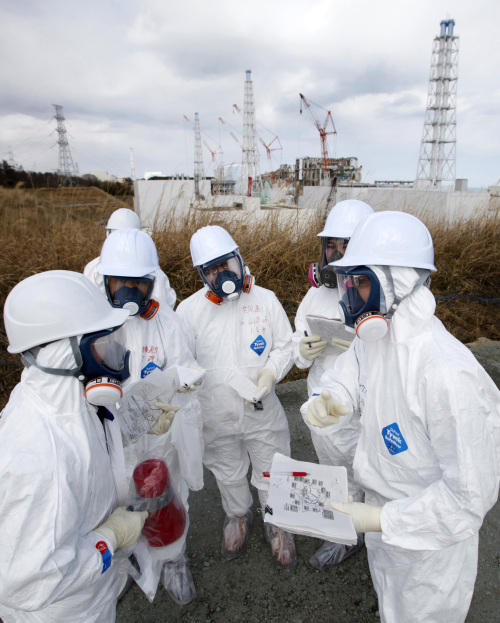Radioactive contamination from the Fukushima power plant disaster has been detected as far as almost 400 miles (643 kilometers) off Japan in the Pacific Ocean, with water showing readings of up to 1,000 times more than prior levels, scientists reported Tuesday.

But those results for the substance cesium-137 are far below the levels that are generally considered harmful, either to marine animals or people who eat seafood, said Ken Buesseler of the Woods Hole Oceanographic Institution.
He spoke Tuesday in Salt Lake City, Utah, at the annual Ocean Sciences Meeting, attended by more than 4,000 researchers this week.
The results are for water samples taken in June, about three months after the power plant disaster, Buesseler said. In addition to thousands of water samples, researchers also sampled fish and plankton and found cesium-137 levels well below the legal health limit.
``We're not over the hump'' yet in terms of radioactive contamination of the ocean because of continued leakage from the plant, Buesseler said in an interview before Tuesday's talk. He was chief scientist for the cruise that collected the data.
The ship sampled water from about 20 miles (32 kilometers) to about 400 miles off the coast east of the Fukushima plant. Concentrations of cesium-137 throughout that range were 10 to 1,000 times normal, but they were about one-tenth the levels generally considered harmful, Buesseler said.
Cesium-137 wasn't the only radioactive substance released from the plant, but it's of particular concern because of its long persistence in the environment. Its half-life is 30 years.
The highest readings last June were not always from locations closest to the Fukushima plant, Buesseler said. That's because swirling ocean currents formed concentrations of the material, he said.
Most of the cesium-137 detected during the voyage probably entered the ocean from water discharges, rather than atmospheric fallout, he added.
Hartmut Nies of the International Atomic Energy Agency said Buesseler's findings were not surprising, given the vastness of the ocean and its ability to absorb and dilute materials.
``This is what we predicted,'' Nies said after Buesseler presented his research.
Nies said the water's cesium-137 concentration has been so diluted that just 20 miles offshore, ``if it was not seawater, you could drink it without any problems.''
``This is good news,'' he said, adding that scientists expect levels to continue to decrease over time.
``We still don't have a full picture,'' Nies said, ``but we can expect the situation will not become worse.'' (AP)
<한글 기사>
日 원전사고 오염 계속된다..태평양 방사능 1천배
美연구진 "650㎞ 떨어진 해수서도 세슘 검출"
작년 일본 후쿠시마(福島) 원전사고 이후 태평양 일부 바다의 방사성 물질 농도가 평소보다 최고 1천 배나 높아진 것으로 나타났다.
미국 우즈홀해양연구소 소속 켄 뷔슬러 연구원은 후쿠시마 원전사고 3개월 후 태평양에서 채취한 검체에서 평소보다 10~1천배에 이르는 방사성 세슘(세슘-137)이 검출됐다고 21일 솔트레이크시티에서 열린 연례 해양과학회에서 발표했다.
뷔슬러 박사는 후쿠시마 제1원자력발전소 해안에서 태평양 쪽으로 32~644㎞ 떨어진 곳에서 수천 개의 해수, 플랑크톤, 수산물 샘플을 채취해 방사성 세슘의 농도 를 측정했다.
후쿠시마 원전사고로 유출된 여러 종의 방사성 물질 중에도 세슘-137은 환경에 오래 남기 때문에 관심 대상이다.
이번 분석 결과 태평양 방사성 세슘 농도는 사고 이전보다 10~1천배 가량 높게 나타났다.
사고 해안에서 무려 644㎞ 떨어진 바다에서도 원전에서 새나온 세슘이 검출된 것이다.
그러나 유출된 방사성 물질은 대양에서 희석돼 인체에 위험한 농도에는 못미쳤다.
후쿠시마 해안에서 멀리 떨어져 있는 곳에서도 방사성 물질의 농도가 상대적으로 높게 나타나기도 했는데 이는 유출된 세슘이 해류의 영향으로 일부 해역에 더 몰리기 때문이라고 뷔슬러 박사는 설명했다.
해수에 들어 있는 세슘-137은 대기가 아니라 원전 배출수가 주원인으로 추정된다.
뷔슬러 박사는 "발전소에서 방사능이 계속 유출됐기 때문에 오염 위기가 완전히 끝났다고 볼 수 없다"고 강조했다.
日 원전사고 오염 계속된다..태평양 방사능 1천배
美연구진 "650㎞ 떨어진 해수서도 세슘 검출"
작년 일본 후쿠시마(福島) 원전사고 이후 태평양 일부 바다의 방사성 물질 농도가 평소보다 최고 1천 배나 높아진 것으로 나타났다.
미국 우즈홀해양연구소 소속 켄 뷔슬러 연구원은 후쿠시마 원전사고 3개월 후 태평양에서 채취한 검체에서 평소보다 10~1천배에 이르는 방사성 세슘(세슘-137)이 검출됐다고 21일 솔트레이크시티에서 열린 연례 해양과학회에서 발표했다.
뷔슬러 박사는 후쿠시마 제1원자력발전소 해안에서 태평양 쪽으로 32~644㎞ 떨어진 곳에서 수천 개의 해수, 플랑크톤, 수산물 샘플을 채취해 방사성 세슘의 농도 를 측정했다.
후쿠시마 원전사고로 유출된 여러 종의 방사성 물질 중에도 세슘-137은 환경에 오래 남기 때문에 관심 대상이다.
이번 분석 결과 태평양 방사성 세슘 농도는 사고 이전보다 10~1천배 가량 높게 나타났다.
사고 해안에서 무려 644㎞ 떨어진 바다에서도 원전에서 새나온 세슘이 검출된 것이다.
그러나 유출된 방사성 물질은 대양에서 희석돼 인체에 위험한 농도에는 못미쳤다.
후쿠시마 해안에서 멀리 떨어져 있는 곳에서도 방사성 물질의 농도가 상대적으로 높게 나타나기도 했는데 이는 유출된 세슘이 해류의 영향으로 일부 해역에 더 몰리기 때문이라고 뷔슬러 박사는 설명했다.
해수에 들어 있는 세슘-137은 대기가 아니라 원전 배출수가 주원인으로 추정된다.
뷔슬러 박사는 "발전소에서 방사능이 계속 유출됐기 때문에 오염 위기가 완전히 끝났다고 볼 수 없다"고 강조했다.










![[From the Scene] Monks, Buddhists hail return of remains of Buddhas](http://res.heraldm.com/phpwas/restmb_idxmake.php?idx=644&simg=/content/image/2024/04/19/20240419050617_0.jpg&u=20240419175937)



![[From the Scene] Monks, Buddhists hail return of remains of Buddhas](http://res.heraldm.com/phpwas/restmb_idxmake.php?idx=652&simg=/content/image/2024/04/19/20240419050617_0.jpg&u=20240419175937)

![[KH Explains] Hyundai's full hybrid edge to pay off amid slow transition to pure EVs](http://res.heraldm.com/phpwas/restmb_idxmake.php?idx=652&simg=/content/image/2024/04/18/20240418050645_0.jpg&u=20240419100350)

![[Today’s K-pop] Illit drops debut single remix](http://res.heraldm.com/phpwas/restmb_idxmake.php?idx=642&simg=/content/image/2024/04/19/20240419050612_0.jpg&u=)